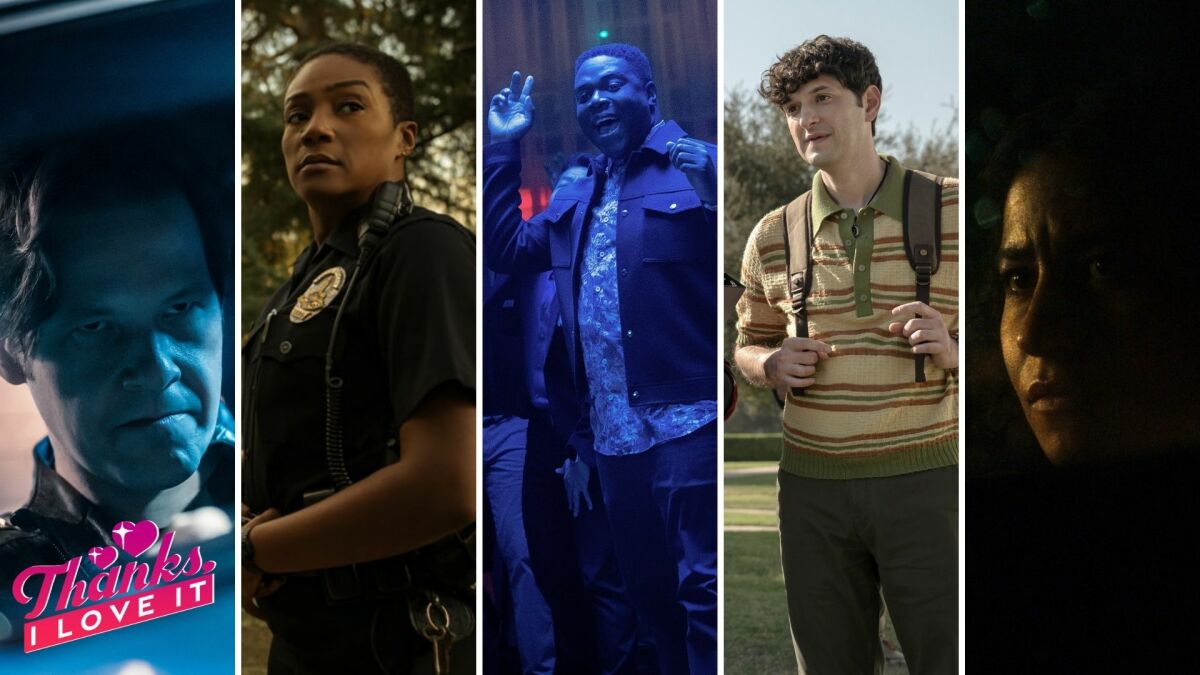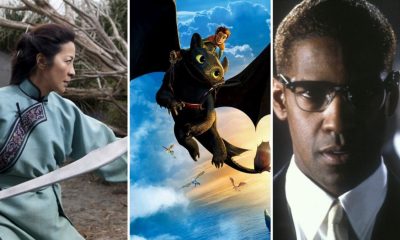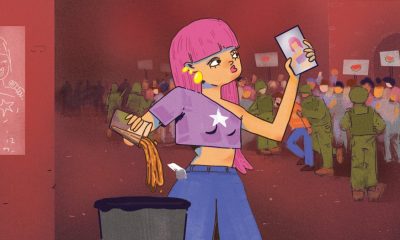Entertainment
‘The Afterparty’ cinematographer shares secrets of every episode’s look

Welcome to Thanks, I Love It, our series highlighting something onscreen we’re obsessed with this week.
As soon as cinematographer Carl Herse heard the idea for The Afterparty, he wanted to work on it.
The murder mystery comedy, created and directed by Chris Miller, is every movie lover’s dream. Each episode retells the night of a deadly high school reunion from a new perspective. These different iterations give us new clues concerning the central mystery of who killed pop star Xavier (Dave Franco), and they take the form of “mind films” exploring different film genres.
“When I found out about this whole visual concept of every episode being a different genre and telling the story a million different ways in a Rashomon-type structure, it was a no-brainer to do the series,” Herse told Mashable over a Zoom interview.
Herse served as director of photography for The Afterparty‘s entire first season. He collaborated with Miller, whom he’d previously worked with on The Last Man on Earth, to create distinct and recognizable looks for each episode. Throughout the preparation process, Herse and Miller discussed which films could serve as references for each genre, and what techniques they could use to perfect each episode’s aesthetic. The result is a show that’s always visually interesting, with fully realized looks that pay tribute to specific films while also getting you into a character’s mindset.
During our conversation, Herse broke down the cinematography of each of the first seven episodes of The Afterparty. Read on to find out which films inspired your favorite mind films, and to learn more about the nitty-gritty of the making of the series.
Episode 1 — “Aniq”

Is it still raining? I hadn’t noticed.
Credit: Apple TV+
As The Afterparty‘s first episode, “Aniq” accomplishes a lot. It establishes the murder and the mind movie concept before launching into Aniq’s (Sam Richardson) account of the night. That means there are four separate looks at play in this episode, including Aniq’s story, which is a romantic comedy.
Anything that happens during the murder investigation is part of what Herse and Miller called the “parlor mystery look.” This includes Detective Danner’s (Tiffany Haddish) interrogations, and Aniq and Yasper’s (Ben Schwartz) attempts to clear Aniq’s name. Herse devised two separate looks for each storyline.
For anything in the present involving Danner, Herse kept everything clean, unfiltered, and realistic. “When [Danner] is holding court, the camera’s moving with her and examining the room and people,” said Herse. “The actors are staged in a tableau that feels like a murder mystery vibe and a little bit like the Coen brothers’ real but slightly expressive way of showing the world.”
While Danner’s look is relatively calm and objective, Herse described Aniq’s as “frenetic.” During scenes where Aniq and Yasper scramble to solve the murder, Herse opted for a handheld approach. “It’s really about showing their lack of control,” he said.
Herse also designed visuals for the episode’s two different mind films. The first is Indigo’s (Genevieve Angelson), which is styled as a black-and-white arthouse film, shot in a square aspect ratio — The Lighthouse was a big inspiration. Indigo’s take on the evening may not be the episode’s main focus, but its striking visuals help the audience understand the general concept of mind films.
“Part of selling the concept to the audience is showing them what kind of range they’re going to be in for,” explained Herse.
“Part of selling the concept to the audience is showing them what kind of range they’re going to be in for,” explained Herse. Aniq’s romantic comedy look isn’t too large a departure from the contemporary timeline, so the show needed something strong and bold, like Indigo’s.
That doesn’t mean Aniq’s romantic comedy look didn’t have any changes from the investigation scenes. For his account of the night, Herse and Miller drew from Hugh Grant films of the ’90s: Think Notting Hill or Four Weddings and a Funeral.
“We tried to find a color that evoked this feeling of optimism and aspiration,” Herse said of trying to capture Aniq’s romantic mood. “We worked really closely with [Bruce Hill] the production designer and [Trayce Gigi Field] the costume designer to work into the set and give us motivation for lighting sources that would be a little lighter and dreamier and the best version of what he could hope for for his evening.”
Episode 2 — “Brett”

Brett living his “John Wick” fantasy.
Credit: Apple TV+
If Aniq’s episode is all about warmth, Brett’s (Ike Barinholtz) action movie episode is all about coolness: being cool, looking cool, and having the cool visuals to match. Literally.
“What we were really responding to were the John Wick films or Atomic Blonde. The more modern, electric, neon tones that you get in these films are unique and strong visually on their own, but also a great contrast to the romantic comedy,” said Herse.
Other visual aspects of the action genre that found their way into Brett’s story were dynamic camera movements, lens flares, and added graininess. “The technique that Chris and I tried to approach this with, we called it ‘death by 1000 cuts,’ where instead of having one big difference, it was a million little differences,” said Herse. “It would be a different ISO, a different format, different lens sets, different color choices, different camera movement, and lens filtration.” This meant that during shooting, which involved shooting multiple genres in a day, the crew had to pay extra attention to all elements of the scene to make sure they were getting the look exactly right.
Episode 3 — “Yasper”

How great is this party?
Credit: Apple TV+
Yasper’s version of the night is a musical filled with bangers, with each song getting the full music video treatment. The standout sequence is hip-hop banger “Two Shots,” which evokes everything from rap battles to Eight Mile.
Flashing, theatrical lighting and choppier camera movement accompany the song to make it feel like we’re in the middle of a contemporary hip-hop music video. Herse even asked the scene’s extras to hold up their cell phone flashlights so they would flare in the lens, creating an excellent background effect.
Herse likened this episode’s musical sequences to films like West Side Story or La La Land: “Everything changes for a moment, a song and dance happens, then the world returns to normal after all this crazy expressive stuff has happened.”
Even when Yasper isn’t breaking into song and dance, Herse made a few tweaks so we still felt like we were in Yasper’s mindset. This included lighting nonmusical scenes with cyan and pink. “We’d use those two to illuminate the space and the characters so that you just felt like everything had a slight difference,” he said. “It was also a little bit more jubilant and expressive than a desaturated look that you’d have in a thriller, where there’s very little color happening.”
Episode 4 — “Chelsea”

Chelsea doing her best “Gone Girl” impression.
Credit: Apple TV+
Speaking of thrillers, let’s dive into Chelsea’s (Ilana Glazer) story: a tense thriller in the vein of David Fincher. Locations we’ve already seen in prior episodes, like the high school’s gym and hallways, suddenly turn into foreboding places rife with danger.
“We joked that any movie that has the word ‘girl’ in the title, like The Girl with the Dragon Tattoo, Gone Girl, The Girl on the Train was one of our touchstones. Really it was the clean, saturated, ominous tone that you get from a Fincher environment that we were going for,” said Herse.
Unlike the previous three episodes, which focused so much on adding to the image, Herse’s approach to the thriller was more subtractive. “After doing those episodes, it was really nice to go into the thriller and strip that all away and find a really clean, dark look that was more about the way the light went through raindrops on a window or the silhouette of a character in the background approaching,” said Herse. “To me that was a nice contrast after three episodes of very dynamic camerawork.”
Episode 5 — “High School”

A blast from the past.
Credit: Apple TV+
The Afterparty‘s fifth episode takes us back in time, where Walt (Jamie Demetriou) retells the story of the high school party that may have laid the ground for Xavier’s murder. For references, Herse and Miller began by looking at Y2K-era films like Can’t Hardly Wait and even earlier teen classics like John Hughes films. However, The Afterparty‘s high school party takes place in the mid-2000s, so Herse and Miller ended up shifting their inspirations up by a few years. This meant looking at grittier, raunchier films like Superbad and Project X.
“Changing the date of the high school period from a Y2K timeline to a mid-2000s timeline really had a noticeable shift in how we approached the material, which is leaning more towards a found footage vibe, trying to make it less like a clean studio teen movie and more of an indie teen movie with a little edge,” said Herse.
After looking at films like Project X, Herse pitched the idea of a character using a video camera at the party, and Miller wrote it in. The episode features sequences involving found footage, but even the non-found footage scenes, shot by handheld cameras, have a similar effect.
Episode 6 — “Zoë”

Things take an animated turn for Zoë.
Credit: Apple TV+
Animation is the perfect way for artist Zoë (Zoë Chao) to tell her story. Miller and his frequent collaborator Phil Lord (who also produces The Afterparty) have a significant background in the medium, working on everything from The Lego Movie to Spider-Man: Into the Spider-Verse and Clone High. According to an interview in The Wrap, they turned to Lindsey Olivares, the production designer of The Mitchells vs. The Machines, to design the characters for Zoë’s episode. Animation company ShadowMachine then animated the episode.
While Herse had little involvement in the creation of the animated sequences, he tried to reference moments from the cartoon sequences in the live-action portions of the episode. For example, when Zoë unleashes her Mama Bear persona in her story, the show cuts back to her looking like a bear, allowing for a humorous match on action.
Episode 7 — “Danner”

Detective Danner’s on the case.
Credit: Apple TV+
With Danner’s episode, The Afterparty returns to live-action, this time mimicking the feel of a cop thriller. Since the bulk of The Afterparty takes place in the Bay Area, Herse and Miller wanted this episode to have a distinctly Los Angeles feel. For that, they turned to films by directors like Michael Mann, Tony Scott, and Antoine Fuqua, whose Training Day served as a big touchstone.
To achieve the right look, Herse used grad filters, which you place in front of the lens to reduce brightness in portions of the image. Herse referred to grad filters as an “underutilized tool in the cinematography handbook these days.”
“If you want a really dark foreboding sky, nowadays you do that in VFX — you darken the sky, add storm clouds,” Herse said. “We did a lot of that in-camera, using these filters that I’m sure no one has used in 20 years to create that dark orange or tobacco-colored sky and this bright, gritty, LA tone.”
Throughout the episode, the camera stays focused on keeping up with Danner. “We wanted everything to be told through [Danner’s] eyes,” said Herse. “We didn’t give any information to the viewer that she could not observe herself.”
Putting it all together

So… whodunnit?
Credit: Apple TV+
As different as all these looks are, Herse and Miller still wanted to create an arc that would connect the genres throughout the season. This meant that techniques used in certain episodes would carry over into others. For example, Herse shot Aniq, Brett, and Yasper’s stories with anamorphic lenses to distinguish them from the present timeline, which he shot with spherical lenses.
The connecting factor of those three episodes is that the characters view themselves as the heroes of their own story. Aniq thinks of himself as a romantic lead, Brett views himself as a family-saving superhero, and Yasper believes that he’s a star in the making. “The anamorphic lens feel a little more cinematic and self-aggrandizing,” Herse explained.
However, as we head into Chelsea’s story, we’re presented with a character who doubts herself. At this point, Herse abandoned the anamorphic lens in favor of a much darker tone. That darkness continues in later episodes, like “High School” and “Danner,” which are also grittier and scrappier than the first three episodes.
“Over the course of the season, you get this evolving representation of the genres,” said Herse. “The idea is to go from a very optimistic, aspirational version of storytelling to a more hyper-real or neo-real perspective.”
Herse also stressed the importance of how The Afterparty‘s writing informed each episode’s look. “It’s all on the page,” he said. “The scripts are so beautifully written that even if you didn’t know what the concept was, I think you would imagine the way we shot this show because it’s just written to be this specific tone. When you read the Brett episode, it feels like you’re reading a John Wick movie. When you read the Danner episode, it feels like a great cop movie.”
-

 Business6 days ago
Business6 days agoGoogle lays off workers, Tesla cans its Supercharger team and UnitedHealthcare reveals security lapses
-

 Entertainment7 days ago
Entertainment7 days agoThe greatest films on Prime Video right now
-

 Entertainment3 days ago
Entertainment3 days agoiPad Pro 2024 now has OLED: 5 reasons this is a big deal
-

 Entertainment6 days ago
Entertainment6 days agoLoneliness in kids: Screen time may play a role
-

 Business5 days ago
Business5 days agoThe Rabbit r1 shipped half-baked, but that’s kind of the point
-

 Business7 days ago
Business7 days agoICONIQ Growth raises $5.75B seventh flagship fund
-

 Entertainment4 days ago
Entertainment4 days agoWhy should we care what celebrities like Taylor Swift and Billie Eilish say about Palestine?
-

 Business3 days ago
Business3 days agoLegion’s founder aims to close the gap between what employers and workers need





















